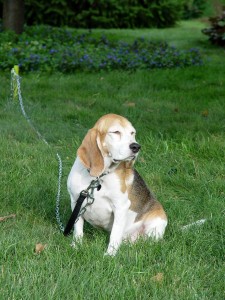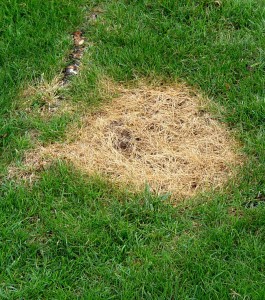Can Dogs and Lawns Co-Exist?
June 27th, 2002
My lawn has survived grubs, voles, snow mold, repeated droughts and punishing soccer games.
This time, though, it has no chance.
My poor blades of bluegrass and fescue are no match for Louie.
Louie is my son, Andy’s, beagle pup. He moved in when Andy moved back home after college. First thing he did was claw up the carpet in two places (Louie, not Andy), then he focused on the yard.
It was only mildly annoying when we started having to pay closer attention when walking to the vegetable garden, if you get my drift.
Then brown spots started appearing in the lawn where Louie had decided to wee-wee.
In spots where he urinated just a little, the grass was actually greener and taller, making it look like the rest of the lawn was sick.
But the crowning achievement was when Louie began digging random holes in the lawn.
He’s not burying anything. Maybe he’s sniffing out bugs or trying to dig a latrine. Or maybe he doesn’t HAVE a reason. Who knows?
What I do know is that this is not good for the lawn. Even the battlefield pictures from Afghanistan are looking greener than my yard.
This raises the question of whether dogs and lawns can peacefully coexist.
“For homeowners who are also dog lovers, this can present a difficult challenge,” says Dr. Steve Thompson, director of Purdue University’s Veterinary Teaching Hospital in West Lafayette, Ind., “especially when one family member prefers the dog and another prefers a well manicured lawn.”
Thompson is a vet who just wrote a paper on this subject for the Turf Resource Center in which his top suggestion is giving ol’ Rover his own pee-free zone.
The area should be covered with pea gravel or mulch and “may even include a marking post like a large boulder, bird bath, lawn ornament or even a faux hydrant,” says Thompson.
The idea is to train the dog that this is the one and only place to “go potty.”
“This could be accomplished by taking the dog out on a leash to the designated spot and rewarding her with a food treat when she eliminates in the appropriate area,” says Thompson.
He says most dogs will catch on in two or three weeks (especially puppies), but a few months might be needed in some cases.
That’s fine if it’s YOUR dog causing the trouble, but what about neighbor dogs?
Thompson says a fence and having a talk with the neighbor are really the only two effective ways to deal with “foreign” dog invasions. He says repellents generally do not work.
“Some odor repellents may actually encourage dogs to overmark the strange smell with their urine,” Thompson says.
One device that may help is a motion-activated sprinkler such as the Scarecrow. These start spraying when something passes near the sensor, but they can waste water.
Thompson says the heart of the problem is the nitrogen in dogs’ urine and feces.
Some nitrogen is good for lawns and plants, but when a dog squats and delivers a concentrated dose, it burns foliage and can even kill branches and patches of lawn.
If you look closely, you’ll often see those brown patches are surrounded by a dark green ring.
“The nitrogen overload at the center causes the burn, but as the urine is diluted out toward the periphery, it has a fertilizer effect,” says Thompson.
Female dogs and young males usually cause more trouble because they squat to pee. Older male dogs are big into marking territory, and they tend to deliver smaller bursts in a lot of areas.
Research by Colorado vet Dr. A.W. Allard found that if you catch a dog peeing on the lawn, you can give the area a good soaking with water and dilute the nitrogen enough to head off damage – but only in the first 8 hours. After that, it’s too late even for water.
Allard also found that the acidity of the urine makes no difference, which shoots many of the home-remedy theories.
Thompson says feeding dogs Vitamin C or potassium citrate supplements or giving them fruit juice or baking soda does not solve the problem and may cause bladder stones or infections.
What can help a little is simply giving dogs more water, says Thompson. That can dilute nitrogen levels enough that plants may not burn.
Ways to increase water in the diet: moistening dry food with water, switching to canned food and adding salt to food to increase thirst. Tomato juice may help, too – not because of some secret effect but because it’s salty and contains a lot of water.
Thompson urges that diet changes should be made only after consulting with a vet or animal nutrition counselor.
Dog poop is less of a problem than urine because it breaks down more slowly and is easier to see and remove. And remove it you should, advises Thompson, because of odor, fly-breeding and diseases that can be spread to humans.
The worst of the diseases is roundworm, which is resistant to disinfectants and even breakdown by weather. That’s why you should never add dog or cat feces to compost piles.
If lawn patches are dead or the dog keeps digging up spots despite your best training efforts, about all you can do (short of getting rid of the dog or the yard) is replant.
Scratch up the soil, lightly sprinkle new seed and keep it consistently moist until new grass is growing. Or cut out dead turf and replace with pieces of sod.
Or switch to Astroturf.
No, wait. That’s a lot like carpet…









